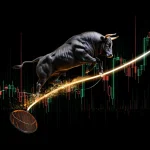Decoding the Asymmetric Dominance Effect
Jan 26, 2025
Introduction: The Illusion of Choice
The greatest trick ever played in human decision-making is the illusion of choice. Enter the Asymmetric Dominance Effect: a psychological lever that tilts preferences manipulates outcomes, and bends markets to the will of those who wield it. At its core, this phenomenon reveals that when faced with two options, introducing a third—*inferior yet strategically flawed*—transforms rational evaluation into a theatre of manipulated desire. Like ancient generals, investors must master this art of misdirection to conquer uncertainty.
Consider a market where two assets vie for capital: one high-risk, high-reward; the other stable but modest. Introduce a decoy—a superficially similar asset with glaring inefficiencies (e.g., marginally higher risk than the first but lower returns)—and watch as the original high-risk option suddenly gleams with irresistible allure. The decoy, though never chosen, reshapes perception. This is not mere theory; it is the alchemy of human bias, where irrationality becomes predictable, and predictability becomes profit.
The Art of Strategic Decoy Placement
To manipulate choice is to govern outcomes. In ancient battles, generals deployed decoy troops to mislead foes; today’s investors craft decoy assets to redirect capital flows. The key lies in designing a comparative trap—a subpar option that amplifies the appeal of its superior counterpart.
Take the tech boom: A company launches three products—a premium model, a standard version, and a deliberately overpriced “middle tier” with negligible upgrades. Though rarely purchased, the middle tier makes the premium appear justifiable, even essential. Similarly, in markets, hedge funds might float a convoluted derivative (the decoy) to make an existing high-fee fund seem prudent by comparison. The decoy’s purpose is not to attract but to distort.
Actionable Insight: Create or identify decoys within your portfolio or target markets. During volatility, sell overpriced “middle ground” options (e.g., covered calls with unattractive strike prices) to nudge investors toward higher-yield positions.
Mastering the Market’s Mind Games
Markets are not rational engines but echo chambers of fear, greed, and cognitive bias. The Asymmetric Dominance Effect thrives here, exploiting mass psychology to amplify herd behavior. When panic strikes, the decoy emerges as a false safe haven—a middling asset that makes reckless speculation seem prudent or excessive caution seems reckless.
In the 2008 crash, gold (a traditional decoy during instability) surged as investors fled equities. Yet gold’s rise was less about intrinsic value than its role as a psychological anchor—a flawed but familiar alternative to collapsing stocks. Those who recognized this dynamic shorted overhyped decoys and pivoted to undervalued equities, turning the crisis into a windfall.
Strategy: Exploit volatility with asymmetric bets. Sell puts on decoy assets during fear-driven rallies, then channel premiums into long-dated calls on fundamentally sound equities. When the herd fixates on the decoy, strike where true value lies.
Mastering the Market’s Mind Games
Technical analysis is not prophecy—it is the archaeology of human behavior. Chart patterns, moving averages, and volume trends are hieroglyphs left by the collective psyche, revealing where decoys have warped rationality. Consider the “head and shoulders” pattern: a decoy rally (the right shoulder) often lures bulls before a collapse. In 2021, GameStop’s parabolic surge saw retail traders fixate on the “cup and handle” pattern, mistaking frenzy for structure. Savvy contrarians shorted the decoy, recognizing that TA without context is a siren’s song.
Actionable Insight: Combine TA with asymmetry. When a decoy asset (e.g., a meme stock) breaches its 200-day moving average amid euphoria, sell volatility. Use premiums to buy puts on the decoy and calls on its true competitor (e.g., a stable sector ETF).
Example: During the 2020 oil price crash, TA flagged WTI’s inverted Bollinger Bands—a signal of extreme fear. Contrarians bought long-dated futures while the herd fixated on decoy “recovery” narratives (e.g., overhyped renewable energy stocks).
Timeless Wisdom for Modern Tactics
History’s strategists understood that victory goes not to the strongest but to the most perceptive. The Asymmetric Dominance Effect is a modern echo of Sun Tzu’s axiom: “All warfare is based on deception.” To master markets, one must think like a philosopher-king—part psychologist, part tactician.
Consider the contrarian who buys during crashes. When others see chaos, they see decoys at play: panic-selling (the irrational third option) that makes undervalued assets appear toxic. By reframing the dominant narrative, they transform collective delusion into opportunity.
Tactic: Deploy decoys in negotiation. When pitching investments, present a conservative option (e.g., bonds) alongside a high-risk venture and a decoy (e.g., a slightly inferior venture). Clients will gravitate toward the high-risk choice, perceiving it as the “smart” middle ground.
Contrarian Compass: When Common Sense Defies the Crowd
Common sense is the rarest commodity in markets. When the crowd flees to decoys, contrarians ask: What is unsaid? In 1999, as dot-com mania crowned profitless startups as kings, value investors like Grantham and Buffett retreated to “boring” sectors—railroads and utilities—assets dismissed as decoys. Their “common sense” was asymmetry in action: the crowd’s obsession with tech made traditional industries appear inferior, but their fundamentals were irrefutable.
Actionable Insight: During euphoria, target sectors branded as “obsolete” (e.g., coal during the ESG boom). When Tesla dominates headlines, buy lithium miners—the silent enablers.
Example: In 2022, contrarians ignored the decoy narrative of “blockchain’s death” and accumulated Bitcoin miners with clean energy pivots as crypto collapsed. By 2023, their infrastructure became the asymmetric play on AI’s power demand.
The Ethical Paradox: Power and Responsibility
Herein lies the rub: To wield asymmetry is to dance with manipulation. Yet knowledge is not corruption—it is clarity. The ethical investor uses this effect not to deceive but to decode the illusions that ensnare others. In doing so, they liberate capital from the clutches of herd mentality.
When tech giants inflate mid-tier pricing to upsell premium products, they exploit asymmetry. The enlightened investor identifies such ploys in IPOs and pivots to disruptors offering true value. The power lies not in participation but in perception.
Imperative: Audit your portfolio for hidden decoys. Are you holding assets because they are optimal or because they seem “less bad” than a decoy? Ruthlessness here is a virtue.
Forging the Future with Asymmetric Insight
The future belongs to those who see beyond the veil of apparent choice. Mastering the Asymmetric Dominance Effect means commanding the battlefield of decision-making—turning noise into signal, chaos into order.
As markets evolve, so too will the decoys. Cryptocurrencies, ESG funds, AI startups—each new arena will spawn its illusions. The wise remain vigilant, dissecting options with a surgeon’s precision and a philosopher’s scepticism.
Final Charge: Be the architect, not the pawn. Design portfolios that exploit asymmetry. Sell decoys to the crowd. Buy truth for yourself. In this dance of dominance, let reason be your compass, and let the illusions of others be your map.
Ultimately, the Asymmetric Dominance Effect is more than a tool—it is a lens through which the astute perceive the invisible hands shaping markets. Master it, and you master the art of turning human frailty into enduring gain.













